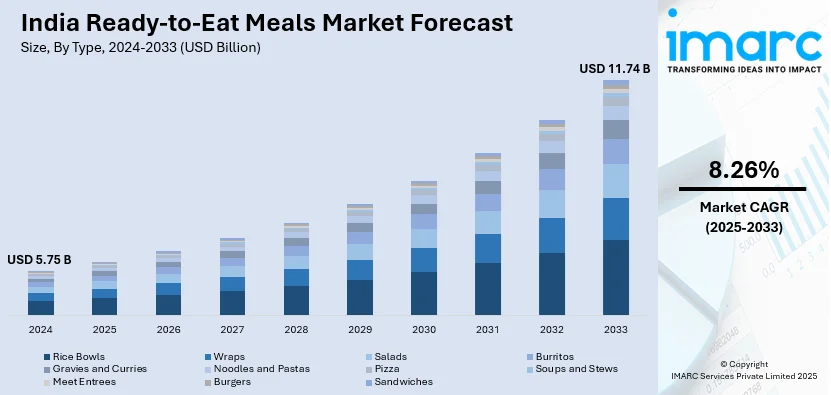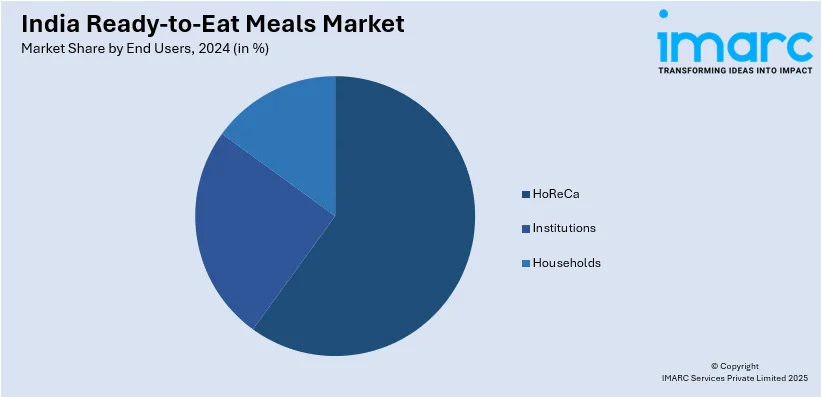
India Ready-to-Eat Meals Market Size, Share, Trends and Forecast by Type, Category, End User, and Region, 2025-2033
India Ready-to-Eat Meals Market Overview:
The India ready-to-eat meals market size reached USD 5.75 Billion in 2024. Looking forward, IMARC Group expects the market to reach USD 11.74 Billion by 2033, exhibiting a growth rate (CAGR) of 8.26% during 2025-2033. The India ready-to-eat meals market share is expanding, driven by the rising need for preservative-free, organic, and protein-rich ready-to-eat meals among health-conscious consumers, along with the expansion of retail outlets that employ appealing packaging and in-store promotions to attract attention and encourage impulse purchases.
|
Report Attribute
|
Key Statistics
|
|---|---|
|
Base Year
|
2024 |
|
Forecast Years
|
2025-2033
|
|
Historical Years
|
2019-2024
|
| Market Size in 2024 | USD 5.75 Billion |
| Market Forecast in 2033 | USD 11.74 Billion |
| Market Growth Rate 2025-2033 | 8.26% |
India Ready-to-Eat Meals Market Trends:
Growing demand for convenience food products
The rising demand for convenience food items is offering a favorable India ready-to-eat meals market outlook. Due to demanding work hours, long commutes, and fast-paced lives, numerous individuals favor ready-to-eat meals with minimal or no preparation needed. Rapid urban development and the increasing prevalence of nuclear families also play a role in this trend, as preparing complete meals each day proves challenging for working professionals and students. The presence of a diverse range of ready-to-eat meals, featuring traditional Indian fare, global cuisines, and health-oriented choices, enhances their attractiveness. Companies are constantly enhancing packaging and extending shelf life, which makes these meals more convenient and simpler to store. Individuals also depend on pre-cooked meals during their travels, as they provide a practical substitute for costly or unhealthy food product choices. For instance, in February 2025, the Ministry of Railways authorized the Indian Railway Catering and Tourism Corporation (IRCTC) to offer ready-to-eat meals on Vande Bharat trains for passengers who opted out of the meal selection during booking. Additionally, the need for preservative-free, organic, and protein-rich ready-to-eat meals is rising among health-conscious consumers. As food technology advances, brands are offering better taste, nutrition, and convenience, making ready-to-eat meals a suitable choice for many individuals.

Expansion of retail channels
The expansion of retail outlets is fueling the India ready-to-eat meals market growth. As per the data released by the Retailers Association of India (RAI), retail sales in April 2024 rose by 4% in comparison to April 2023. The food and grocery industry showed an increase of 7%. Supermarkets, hypermarkets, convenience stores, and online grocery services are making ready-to-eat meals more accessible and easier to buy. Large retail stores allocate whole sections for ready-to-eat items, providing a range of choices from instant curries and rice dishes to pasta and global cuisines. The adoption of e-commerce portals has further enhanced accessibility, enabling customers to order meals with a few clicks. These platforms additionally provide discounts and subscription choices, promoting recurring purchases. Furthermore, contemporary retail outlets employ appealing packaging and in-store promotions to attract attention to read-to-eat meals, boosting impulse purchases. The availability of these meals in smaller convenience shops and fuel stations offers a convenient option for individuals seeking a quick meal while on the move. As brands collaborate with retailers to broaden distribution channels, ready-to-eat meals are penetrating smaller towns and rural regions, establishing new markets. As retail infrastructure enhances, the market in India persists in its steady growth.
India Ready-to-Eat Meals Market Segmentation:
IMARC Group provides an analysis of the key trends in each segment of the market, along with forecasts at the regional level for 2025-2033. Our report has categorized the market based on type, category, and end user.
Type Insights:
- Rice Bowls
- Wraps
- Salads
- Burritos
- Gravies and Curries
- Noodles and Pastas
- Pizza
- Soups and Stews
- Meet Entrees
- Burgers
- Sandwiches
The report has provided a detailed breakup and analysis of the market based on the types. This includes rice bowls, wraps, salads, burritos, gravies and curries, noodles and pastas, pizza, soups and stews, meet entrees, burgers, and sandwiches.
Category Insights:
- Gluten-Free
- Conventional
A detailed breakup and analysis of the market based on the categories have also been provided in the report. This includes gluten-free and conventional.
End Users Insights:

- HoReCa
- Institutions
- Households
The report has provided a detailed breakup and analysis of the market based on the end users. This includes HoReCa, institutions, and households.
Regional Insights:
- North India
- South India
- East India
- West India
The report has also provided a comprehensive analysis of all the major regional markets, which include North India, South India, East India, and West India.
Competitive Landscape:
The market research report has also provided a comprehensive analysis of the competitive landscape. Competitive analysis such as market structure, key player positioning, top winning strategies, competitive dashboard, and company evaluation quadrant has been covered in the report. Also, detailed profiles of all major companies have been provided.
India Ready-to-Eat Meals Market News:
- In March 2024, SATS Food Solutions India (SFSI), a fully owned subsidiary of SATS Ltd (SATS), inaugurated its biggest international food solutions facility in Bengaluru, India. The plant, located near Kempegowda International Airport and covering 221,000 sq. ft, aimed to serve as the central kitchen for the company’s newly introduced ready-to-eat meals division in India. The organization allocated SG$61 Million (INR 378 Crore) for the establishment of this new facility.
- In March 2023, Brand Ammamma's, a well-known convenience food item brand, was ready to introduce its premium and fiber-packed ready-to-eat food items in Bangalore, India, with the help of strategic logistics partner, Green Drive Mobility. The offerings featured a range of packaged chapati items, and Poori, Parota, Dosa, and Idly Batter. It aimed to grow to 1800 outlets within the nation.
India Ready-to-Eat Meals Market Report Coverage:
| Report Features | Details |
|---|---|
| Base Year of the Analysis | 2024 |
| Historical Period | 2019-2024 |
| Forecast Period | 2025-2033 |
| Units | Billion USD |
| Scope of the Report |
Exploration of Historical Trends and Market Outlook, Industry Catalysts and Challenges, Segment-Wise Historical and Future Market Assessment:
|
| Types Covered | Rice Bowls, Wraps, Salads, Burritos, Gravies, Curries, Noodles, Pastas, Pizza, Soups,Stews, Meet Entrees, Burgers, Sandwiches |
| Categories Covered | Gluten-Free, Conventional |
| End Users Covered | HoReCa, Institutions, Households |
| Regions Covered | North India, South India, East India, West India |
| Customization Scope | 10% Free Customization |
| Post-Sale Analyst Support | 10-12 Weeks |
| Delivery Format | PDF and Excel through Email (We can also provide the editable version of the report in PPT/Word format on special request) |
Key Questions Answered in This Report:
- How has the India ready-to-eat meals market performed so far and how will it perform in the coming years?
- What is the breakup of the India ready-to-eat meals market on the basis of type?
- What is the breakup of the India ready-to-eat meals market on the basis of category?
- What is the breakup of the India ready-to-eat meals market on the basis of end user?
- What are the various stages in the value chain of the India ready-to-eat meals market?
- What are the key driving factors and challenges in the India ready-to-eat meals market?
- What is the structure of the India ready-to-eat meals market and who are the key players?
- What is the degree of competition in the India ready-to-eat meals market?
Key Benefits for Stakeholders:
- IMARC’s industry report offers a comprehensive quantitative analysis of various market segments, historical and current market trends, market forecasts, and dynamics of the India ready-to-eat meals market from 2019-2033.
- The research report provides the latest information on the market drivers, challenges, and opportunities in the India ready-to-eat meals market.
- Porter's five forces analysis assist stakeholders in assessing the impact of new entrants, competitive rivalry, supplier power, buyer power, and the threat of substitution. It helps stakeholders to analyze the level of competition within the India ready-to-eat meals industry and its attractiveness.
- Competitive landscape allows stakeholders to understand their competitive environment and provides an insight into the current positions of key players in the market.
Need more help?
- Speak to our experienced analysts for insights on the current market scenarios.
- Include additional segments and countries to customize the report as per your requirement.
- Gain an unparalleled competitive advantage in your domain by understanding how to utilize the report and positively impacting your operations and revenue.
- For further assistance, please connect with our analysts.
 Inquire Before Buying
Inquire Before Buying
 Speak to an Analyst
Speak to an Analyst
 Request Brochure
Request Brochure
 Request Customization
Request Customization




.webp)




.webp)












